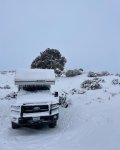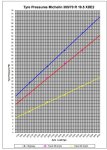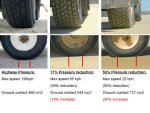1000arms;
Thanks for a comprehensive post. I have a lot to learn about.
Should one disengage rear (or front) lockers on curves?
My dad used tire chains in the 50's. Still remember him putting them on. Every few years I say I'm gonna buy a set but never follow through.
I like the flatbed setups. Apart from the $300k ready made ones, some of the DIY setups are incredible. If I were to build one (and I won't...too old and not enough motivation therefore) I'd want radiant floor heat if possible. Maybe also run the tubing so it'd keep the fresh water tanks and plumbing (to sink, shower) from freezing.
Many of the flatbeds, though, are beyond what I wish to pay. That may change as I get closer to actually buying one preparatory to my travel/relocation plans.
This backpacking electric bear fence puts out 1.8 Joule and weighs 2.4 lbs. The battery powered energizer puts out 1.8 Joules at the terminals, and 1.0 Joules through the wiring. Under the URL is the owner's response to my questions. She responded to several other questions, also. For a camper I'd get a more substantial setup with larger fenced area.
Thanks again, 1000arms. I'll be reading the truck camper sites you posted.
You are welcome!

Having a locker in the front differential and the rear differential AND being able to select whether each locker is engaged or disengaged (independent of the other locker) would probably be the best for what you seem to want to do, BUT keep in mind that isn't necessarily a requirement. My Jeep TJ Wrangler with an open front differential and a limited-slip rear did take me many places.

(The "Rubicon" Wrangler I mentioned in my earlier post would be a lot more capable.)
There is a thread on this forum about unlocking the rear-locker when turning (while moving forward) to better allow the vehicle to turn, but the reference I made in my earlier post was about the danger of a automatically-locking locker engaging on a curve on a snowy or icy road. Such engagement can easily put the vehicle in to a skid. I have driven a two-wheel drive truck with such an auto-locker through lots of snow and ice with good tires, 700 pounds of sand under a fiberglass cap, and simply been careful with the skinny-pedal on the curves.
With independently select-able lockers, you would be able to disengage the rear locker during a forward turn for more steer-ability, but could re-engage the rear-locker if you needed the traction more than the steer-ability.
New and used truck prices are pretty high right now, but keep in mind that ordering a vehicle (or finding one on the lot if you are lucky enough) with the gearing and lockers/limited-slips that you want can be much cheaper than changing/adding them later.
Look up V-bar ice chains. Muwahaha! 
Make sure your vehicle will have room enough to use them on all four corners. Pick up another two pairs of chains that you can use on the road.
A truck (pickup frame or chassis cab frame) with a flatbed would allow for a simple insulated box. Maybe build one yourself, maybe have one made? Build the interior yourself, or maybe pay someone to build it for you? Keep all your tanks and hoses within the insulated box.

Dual rear wheels (DRW) would likely give more stability and weight capacity, but single rear wheels (SRW) would be easier to fit in and out of places, track the front wheels better in the snow and mud, and be easier to air down (DRW can rub at low pressure depending on the tire and the spacing).
Different rims have different load capacities. Be aware that some size rims don't hold a bead well when airing down. Tires may be available in different load ranges and/or rim size. Another rabbit hole for you.

DRW would about 8' wide, so why not have an 8' wide camper so that you can sleep without your head/feet jammed in to the walls (and without the long cabover needed for a front to back bed)? Perhaps too wide?
Alaskan Camper does make hard-sided pop-up truck campers, but check the interior height.
http://alaskancampers.com/alaskan-campers-features-pricing/
You might want the right pop-up camper?
The 2017+ Super Duty pickups have pretty tall pickup-bed-floor to top-of-cab heights. Older campers might require a spacer under the camper to fit. You might want to look at the newer/new F-350 with the 7.3 L gas engine and the 4.30 (differential gearing) with locker (or limited slip with DRW). Lots of low end torque and gears good for slow careful offroad travel, but a 10-speed transmission which will also work well on the highway.
If a CCSB (Crew Cab Short Bed) would work for you, look for the "Tremor" F-350 (XLT or higher trim, CCSB only). I wish they would make a RCLB "Tremor" F-350.
I haven't watched them, but you might want to look at the Alaska Department of Fish and Game "Electric Fences as Bear Deterrents" videos:
Alaska Department of Fish and Game

www.adfg.alaska.gov











